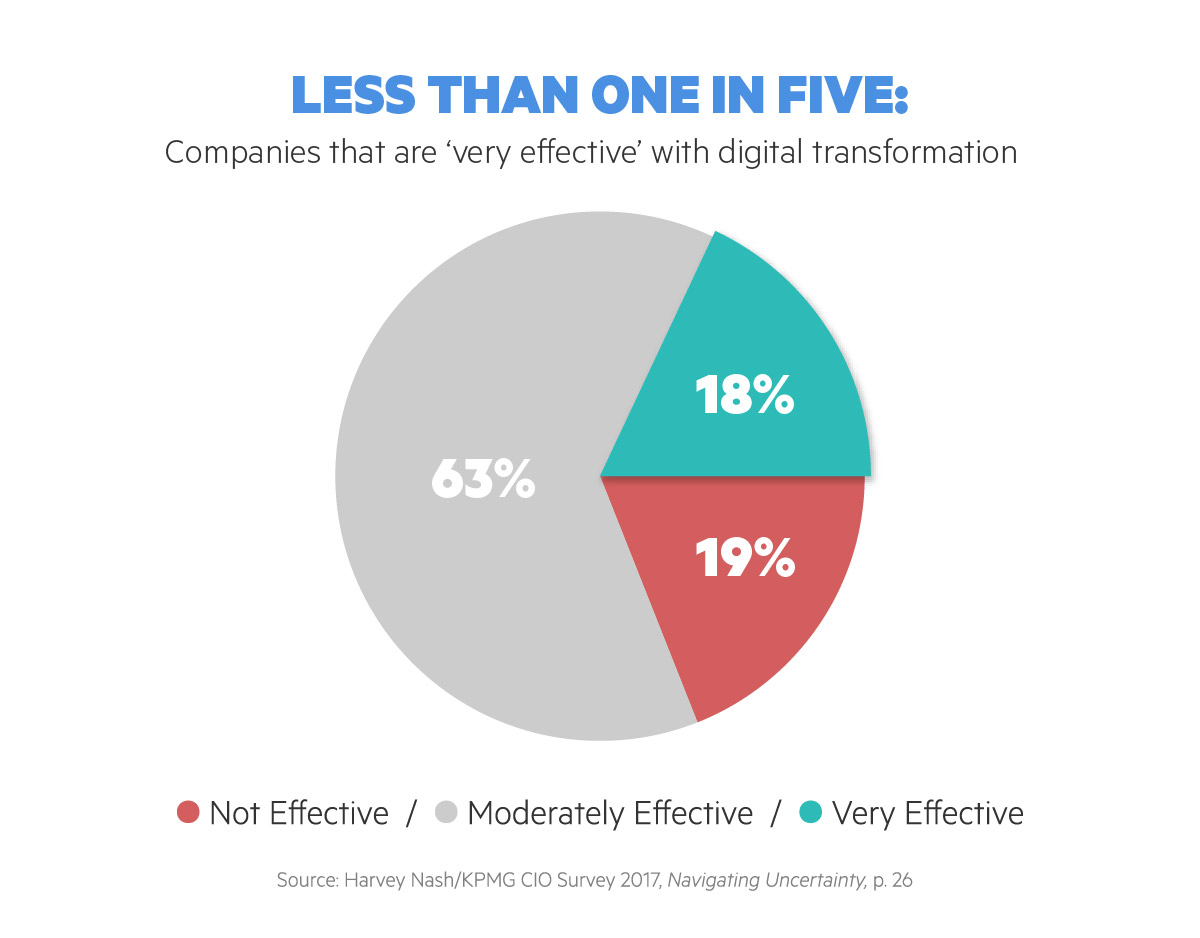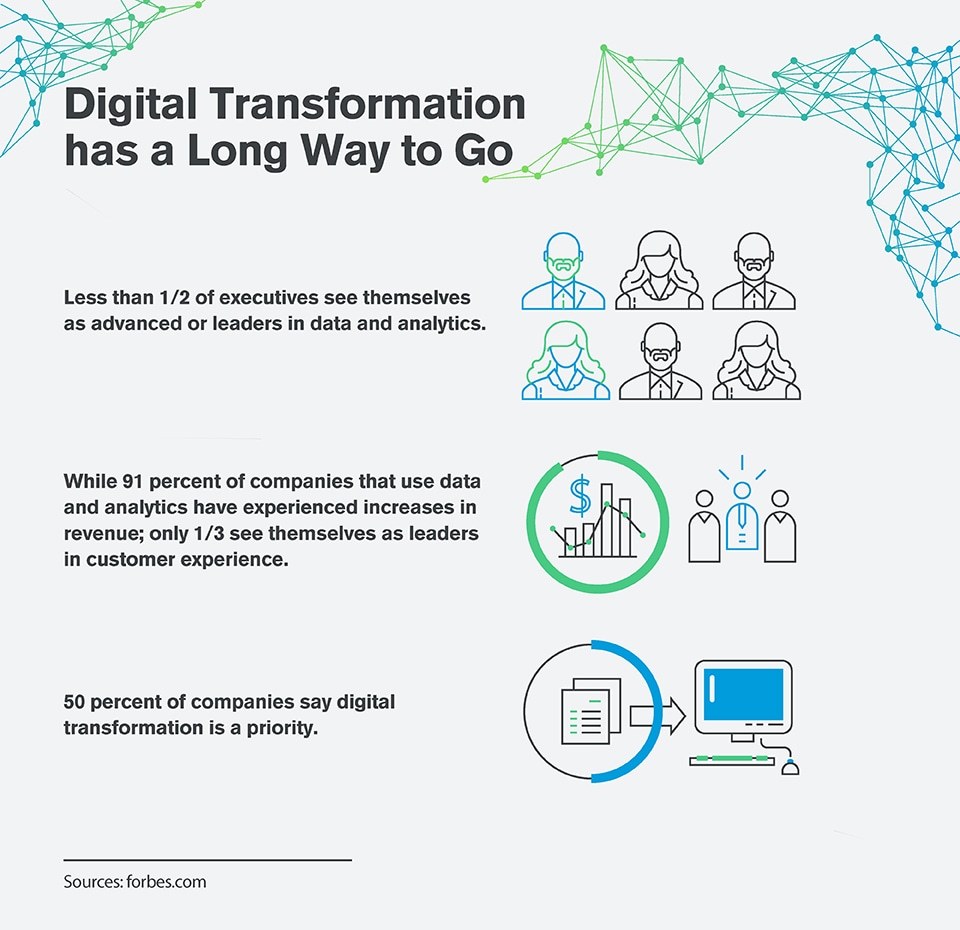Wake up and smell the digital roses.
Digital transformation ain’t easy.

While it’s a necessity for remaining viable in a hyper-competitive business landscape shaped by mobile, agile, and globalization, it’s not something that you can just plug-and-play into your company and expect it to work seamlessly.
A staggering 70% of digital transformations fail. And less than one in five companies are deemed “very effective” with digital transformation.
Digital transformations are massive efforts that are typically undertaken in pursuit of new business models and new revenue streams, driven by changes in customer expectations around products and services. In fact, Gartner says that two-thirds of businesses recognize their company must digitize by 2020 in order to stay competitive.
They require leadership of the CEO and executive team, as well as cross-departmental collaboration in pairing business-focused philosophies with new digital development models. Despite its critical importance, a surprising number of transformation efforts fail, even at some of the world’s largest, most profitable, and innovative organizations.
The Fortune 500 Digital Transformation Money Pit
Last year alone, companies poured $1.3 trillion into transformation initiatives — 70% of which was wasted on failed programs at companies like Ford, GE, and Procter & Gamble.
Wow.

For those companies that didn’t fail outright, only 16% saw improvements in their performance and ability to sustain change over the long haul. Even for digital-first industries like high-tech, media and telecom, only 26% saw success.
So let’s take a look at the reasons why GE, Ford, and P&G failed at digital transformation, which will help provide guidelines to help others avoid failure and ensure success with digital transformations.
Ford Motor Company

Ford attempted a digital transformation in 2014 by creating a new segment called Ford Smart Mobility, with the goal of building digitally enabled cars with enhanced mobility. Problems began when the new business unit was isolated from the rest of Ford, where it was headquartered far from the rest of the company, and it was seen as a separate entity with no cohesion to other departments. Ford continued to dump tons of money into its new venture, even as it faced quality concerns in other areas of the company. Ford’s CEO stepped down a few years later as their stock price dropped dramatically.
Key Learning:
Integrate digital transformation efforts with the rest of the company. In this case, digital transformation as less of an actual transformation and more of a pivot into a new business area. To be successful, digital transformation needs to be integrated into the company.

GE
GE initiated a major transformation effort in 2011 to enter the digital software space by building a huge IoT platform, adding sensors to products and transforming its business models for industrial products. It then created a new business unit called GE Digital in 2015 with the goal to leverage data to turn GE into a technology powerhouse.
Despite pouring billions of dollars and thousands of employees into GE Digital, the company’s stock price continued to drop and other products suffered. GE Digital quickly became stuck in the pattern of having to report earnings to shareholders and was focused more on short-term goals and earnings than long-term innovative goals and returns. The CEO was soon forced out.
Key Learning:
Keep the focus on quality over quantity. GE didn’t have strategic focus in a single area and tried to do too much. The company was simply too large to transform all at once, especially without a true vision of what it was trying to achieve. Digital transformations are often done best with a handful of passionate people leading the charge instead of thousands of employees.

P&G
In 2012, consumer packaged goods giant Procter & Gamble set out to become “the most digital company on the planet.” The company was already leading the industry when it decided to take things to the next level with a digital transformation. However, its broad goal led to broad initiatives that lacked purpose. Coupled with a slumping economy, P&G faced problems from the start. The CEO was soon asked to resign by the board.
Key Learnings:
Competitive and economic analysis are paramount when developing strategy. The ROI for a widespread and expensive digital transformation was small, especially with a cooling economy ahead. Focusing on smaller digital efforts that were more targeted to its existing products and processes would have yielded better results. It failed to look at what was going on in the industry to see it was already ahead of competitors as well as the warning signs on the economy.
It’s worth mentioning, that while these companies failed at their initial digital transformation efforts, they were able to make adjustments to succeed in the future.
The Real Trillion Dollar Reason Behind the Failure
I’ve heard just about every reason and excuse for organizations failing at digital transformation, although my favorites are blaming the employees or the vendors tasked to help guide the transformation.
I’ve had tons of experience working at many Fortune 500 companies, including Marriott during an Agile transformation effort in 2012. I’ve found that the primary culprit is the failure to develop a cohesive vision for change, as well as the lack of communication about the needs and expectations for the change across a large organization.
However, this is just symptomatic of the larger problem of organizations that lack a design culture, i.e. the ability to continuously learn/adapt, think differently, and innovate.
Once a company becomes successful, matured, and grows into a large company, the culture takes on a life of its own and can quickly devolve into a complacent, change-resistant, and even toxic workplace.
Conclusion
Trying to introduce massive change into a culture that isn’t built for it will result in epic failure. It requires the right leadership as well as significant time and resources to ensure it evolves correctly as the company grows. And most companies have a long way to go before they attempt a digital transformation.

I’ve always recommended Strategic Design as the best framework to build and grow businesses to not only compete, but to innovate and dominate. It truly is unlike any traditional approach to building and growing a business, where it requires a unique mindset that’s radically different from what you learned in Business 101. Only those that are dedicated to innovation, challenging the status quo, and a deep desire to be the leader in their market will be successful.



One thought on “The Trillion Dollar Reason Fortune 500 Companies Fail at Digital Transformation”